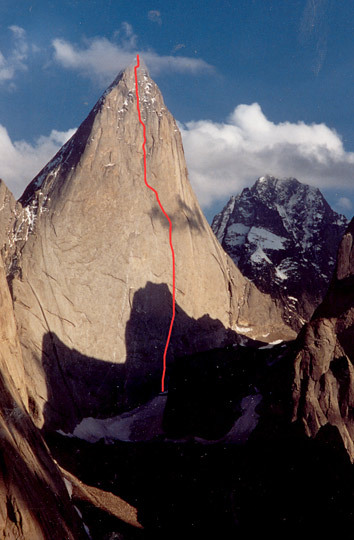
The west face of Pik 4810 above the Kara-su valley in Pamir Alai. Marked is the line of the Voronov Route, which recently received a winter ascent from a St. Petersburg team. There are around ten routes on this 1200-meter face. [Photo] Mountain INFO
A strong team of climbers from St. Petersburg, led by Valeri Shamalo, who last year was a member of the successful Russian expedition to the West Face of K2 (see “K2—The Russian Route” in Alpinist 23), has braved the harsh conditions of Kyrghyzstan’s Pamir Alai to make an impressive winter ascent of the Voronov Route on Pik 4810. Details are currently lacking but will be added as they become available. However, apart from Shamalo, the team comprised one female alpinist, Galina Chibitok, and three other males–Dmitry Krasnov, Rustem Nagaev and Dmitry Polenov–all of whom reached the summit on March 14.
Pik 4810, sometimes referred to as Pik Boston (4810m) is an impressive rock spire straddling the watershed ridge between Ak-su and Kara-su valleys in the famous Karavshin region of the Pamir Alai. The Voronov Route lies on the sheer and striking west face, south of Pik 1000 Years of Russian Christianity, and is accessed from the Kara-su. This area of stupendous rock walls was first discovered during a helicopter reconnaissance in the early 1980s, and 4810 was first climbed during the 1986 Soviet Alpinist Championships by Sitnik’s team via the north ridge (5B). The 1200-meter west face became the target of four teams “competing” in the 1988 Championships; all completed hard big-wall routes warrenting a Russian grade of 6A or 6B. The Voronov Route climbs more or less up the center of the triangular face, involved much aid and has been reported at grades of 6A or 6B.
Although Western climbers visited this area from the late 1980s onward, the first non-Soviet ascent of a major route on the west face may not have taken place until 1999 when Roxanna Brock and Brian McCray spent ten days repeating the 1994 Sakharov Route toward the left side of the wall. Notably, in 2002 the first foreign visitors to the area after the now-infamous terrorist activities of 2000 involving American and German climbers, was a group of Czechs. Splitting into three teams, they climbed one route on each side of the Sakharov, the one to the right, named Otikovy mokre sny, going all free at around 5.12d, and repeated the Krizok route closer to the center of the wall. There are now around ten routes on this face.